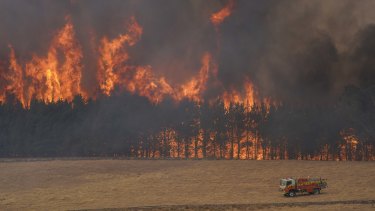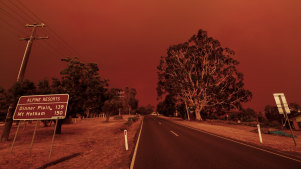The mega-blaze: How did it happen and what does it mean?
NATIONAL
NSW
BUSHFIRES
The mega-blaze: How did it happen and what does it mean?
Our coverage of the bushfire crisis is free for all readers. Please consider supporting our journalism with a subscription.
By Janek Drevikovsky
January 12, 2020 — 12.19am
On Friday night, two massive fires near the NSW-Victorian border merged into one. By Saturday morning, a third fire had joined the massive blaze, which now stretches south from Kosciuszko National Park all the way to the Victorian banks of the Murray River.
The three blazes began separately on December 28 last year, likely the product of lightning strikes. They quickly consumed huge amounts of countryside, before Friday’s powerful winds forced their merger.

The East Ournie Creek and the Dunns Road fire zones came together near the village of Tooma to form a 'mega-fire'.CREDIT:EDDIE JIM
According to Victorian Emergency Services Minister Lisa Neville, the three fires have destroyed 800,000 hectares in both Victoria and NSW, an area eight times bigger than the Island of Hong Kong.
In contrast, the huge Gospers Mountain fire on the mid-north coast took nearly two months to burn through 440,000 hectares.
Advertisement
Despite its extreme size, the new mega-blaze might be a blessing in disguise for battling fire crews.
“In a way, where they touch up, it is a good thing because they’re running out of fuel,” RFS commissioner Shane Fitzsimmons said on Saturday.
Paul Muir, the deputy incident controller for part of the mega-blaze, agreed the development could be positive, though for different reasons.
“In some ways it does help. We only have two active edges,” he said. “We’ve lost one active edge [where the fires merged].”
Advertisement
Mr Muir said his team never wanted the fires to merge, but with calmer weather, there might be an opportunity to get the situation under control.
RELATED ARTICLE

BUSHFIRES
Father-of-two dies battling Omeo bushfireAdd to shortlist
“With the weather, they are slowing. They’ve dropped back today. With a bit more humidity in the air, [there’s a chance] to put the control lines in.”
The mega-blaze was formed by a collision of the Dunns Road fire which began west of Adelong; the East Ournie Creek fire from just north of the Murray; and the Green Valley fire which started east of Albury.
Late last year, the Green Valley fire took the life of RFS volunteer Samuel McPaul after cyclonic winds knocked over his fire truck.
Advertisement
A week into January, the Dunns Road fire covered a terrifying 313,000 hectares and was savaging Batlow and surrounds. Apple orchards were incinerated, houses were lost and the famous Sugar Pine tourist walk was gutted by flames.
David Harrison from Goulburn died of a heart attack while defending a friend’s Batlow home from the inferno.
By Friday morning, the Dunns Road and East Ournie blazes were just 300 metres apart. Then, with winds raging, the two fires crashed into one another, their fronts merging.
Around the same time, “a finger” of the Green Valley fire began jutting into the East Ournie Creek blaze, completing the merger.
Locals have feared the merger for some time.
Advertisement
“It was predicted a week ago,” said Sue Scanlon, publican at the Tumbarumba Hotel. “That’s always been the biggest threat for Tumbarumba.”
But the town had a reprieve when 100 km/h winds, predicted for Friday night, did not arrive.
The RFS cannot say when the mega-blaze will be extinguished. “Rain is about the only thing that can help us,” Mr Muir said.
BUSHFIRES
NSW RURAL FIRE SERVICE
No comments:
Post a Comment